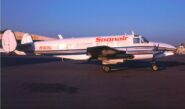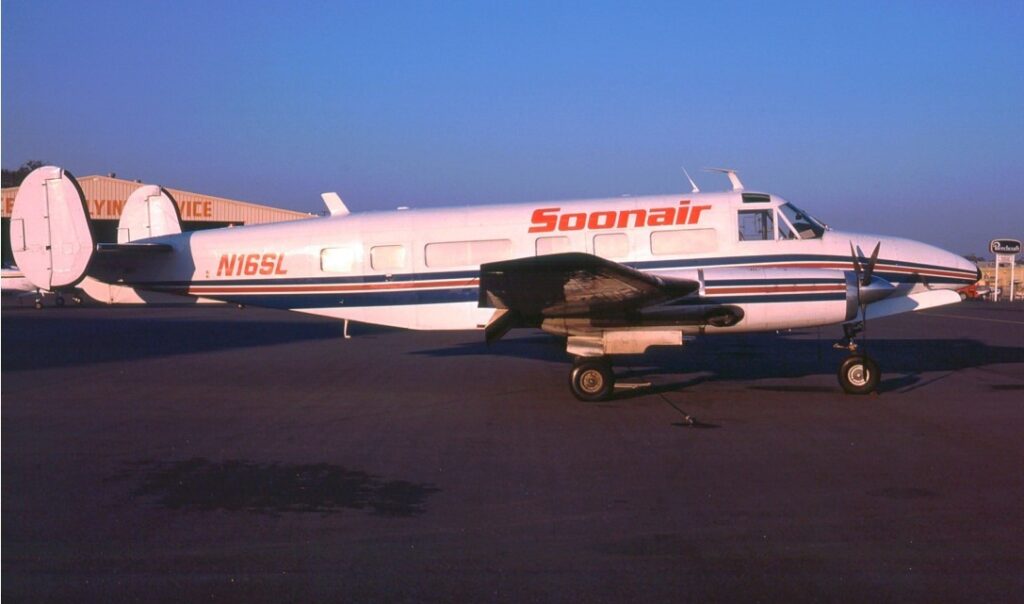Airline,airliner,airlines,Beech 18,Federal Express,pilot career,Soonair,Tulsa,Volpar Turboliner

TURBOPROPS, ROUND ONE: Soonair Volpar Turboliner
By Ellis M. Chernoff
With a newly added Flight Engineer-Turbojet certificate in my wallet, I again set out with an updated resume and submitted applications to all of the airlines. But my expectations of getting a seat in the cockpit of an airline were dashed following the crash of an American Airlines DC-10 at Chicago in 1979. I returned to California to scour the pages of “Trade-A-Plane” and other sources for potential pilot employment information. Meanwhile, local efforts to gain a position with the three airlines based at LAX (Western Airlines, Continental Airlines, and Flying Tiger Lines) did not amount to anything. Neither did my attempt to get an entry-level position with Golden West Airlines or Sun Aire Lines. Golden West required pilots to go to Toronto and buy training at the factory for the DHC-6 Twin Otter. Sun Aire had no openings; even if they did, I wasn’t competitive. They required currency in the Swearingen Metroliner just to be considered.
Finally, I spotted a “pilot wanted” listing for an operator in Tulsa, Oklahoma. After a quick phone call, I bought an airline ticket and went for an interview with the Director of Operations. He was impressed with my experience. He was offering a captain position, which would entail two weeks flying plus a week of flight following duties each month for a salary. Soonair Lines operated six turboprop airplanes: three Volpar Turboliners and three SA-226TC Metroliners on cargo contracts with Purolator Courier, Federal Express, and Emery Air Freight.
I was a bit concerned about one issue: as I was being hired as a captain, what would happen when the existing first officers gained sufficient time to upgrade? I was assured that my position would always be captain. With that, I returned home to once again pack my car and drive to Tulsa.
While getting oriented with new company manuals and employment details, I quickly set up an apartment and other necessities of starting a new job. One other new captain had also been hired, and the two of us met with the chief pilot one night to get checked out in the Volpar.
In the mid-1960s, there weren’t many commuter or regional aircraft types. Mainly for the Allegheny system, the Volpar Company at Van Nuys Airport took surplus Beech 18/C-45 airframes, added some wing area, stretched the fuselage, added their STC nose gear package, and replaced the P&W R-985 piston radial engines with Garrett TPE-331 turboprops. These engines increased the power from 450 to 620hp each while also reducing frontal drag. As an early commuter passenger plane, it offered 12-15 seats. Increased speed and payload were added benefits. As the Volpars were replaced with Beech 99 aircraft, they were stripped of passenger fittings and converted to freighters.
During the single night of flight training, we did all of the usual maneuvers with the added test of full takeoffs under the hood (zero-zero). However, since the other pilot went first, only he got to actually start the engines. But my FAR 135 proficiency check was complete with an authorization for reduced minimums.
My first line flight would occur on November 2, 1979, with a positioning flight from Tulsa to Little Rock Adams Field. The boss came out to make sure that I could get the engines started! This would also be the last time I would ever operate an airplane “solo,” although there would be times when I might as well have been alone.

Those familiar with the Garrett turboprop probably think of the latest versions that have all sorts of automatic features. The Volpar had the earliest version, TPE-331-101, which was not flat-rated nor did it have any automatic limiters. The only automatic feature was the start sequence. The Turboliner did not have nose wheel steering but was very easy to handle on the ground by deft use of the propellers. Engines are started with the propellers in flat pitch, and the power levers move forward to go forward, and aft to produce BETA, or negative thrust to slow or help with turns.
It was a real rocket ship, but exceptionally loud in the cockpit. That nose was like an aluminum bullhorn amplifying the prop noise to the cockpit. Temperature control was a challenge, too. As the season was already autumn, only heat was needed, but the original heat distribution plumbing had been removed. Two needle valve knobs opened raw hot bleed air to respective pilot floor outlets. Your socks could be melting while your thighs were freezing.
The Purolator runs were from Little Rock non-stop to Columbus, Ohio, where the sort occurred. Offload and loading crews handled the cargo there, but the pilots and copilots had to do the work at the out stations. The return flight was from Columbus to Memphis, TN, continuing back to Little Rock with arrival around dawn.
The Volpar Turboliner had good space for bulk cargo. Loading was facilitated with a large door on the left rear of the cabin. A tail stand was attached to the tail tie-down fitting, and as long as it hung above the pavement, without touching the surface, the load would be within balance limits. Pilots entered the cockpit via a pilot door, but the flaps had to be fully down for a step to access the wing to allow pilot entry.
Following days off and flight following duty in my apartment in Tulsa, I was given an airline ticket to Boston. Before I departed, I had a meeting with the director of operations (D.O.). He informed me that my plane would park and layover during the day in front of the FAA office at the Portland, Maine airport (PWM). I could expect an FAA inspector to meet me and challenge the airworthiness of our aircraft. I said that didn’t worry me; I had a lot of experience with the FAA. The D.O. had been impressed by not only my professionalism, but he could tell that I was not easily intimidated.
So it was that I took the Soonair Volpar, full of Federal Express packages, from Boston to Portland on the morning of December 1 and was met by the FAA on the ramp as soon as I arrived. As expected, he demanded the aircraft logs and challenged the airworthiness of the airplane, with specific attention to the de-icer boots. My reply to him was that as pilot in command, it’s my responsibility to determine that the plane was airworthy and legal to fly and that I was not a suicidal maniac. Perhaps the plane looks like an obsolete junker, but everything functions. I never saw that inspector again.
Operating flights for Federal Express was a bit different than for Purolator. One of the essential duties was to phone in a flight closeout ASAP after each flight. Federal Express had established times for every flight that included block out, takeoff, landing, and block in. So, I phoned in my first report after arriving in Portland a few minutes early.
“What was your delay, Captain Chernoff?”
“Huh?”
“Your delay, sir. You blocked out three minutes late.”
“But I arrived early,” I said.
“Why did you block out three minutes late and take off 1 minute late?”
From then on, I understood how the “Purple Air Force” worked. It would serve me well years later.
The Portland run was simply to fly PWM-BOS and then spend the entire night in the FBO at Boston. When the big purple plane returned from Memphis, the cargo would be transloaded and we would fly back to PWM, where the company provided one motel room for day use for the two of us pilots. The glory of building turbine time 45 minutes at a time.
